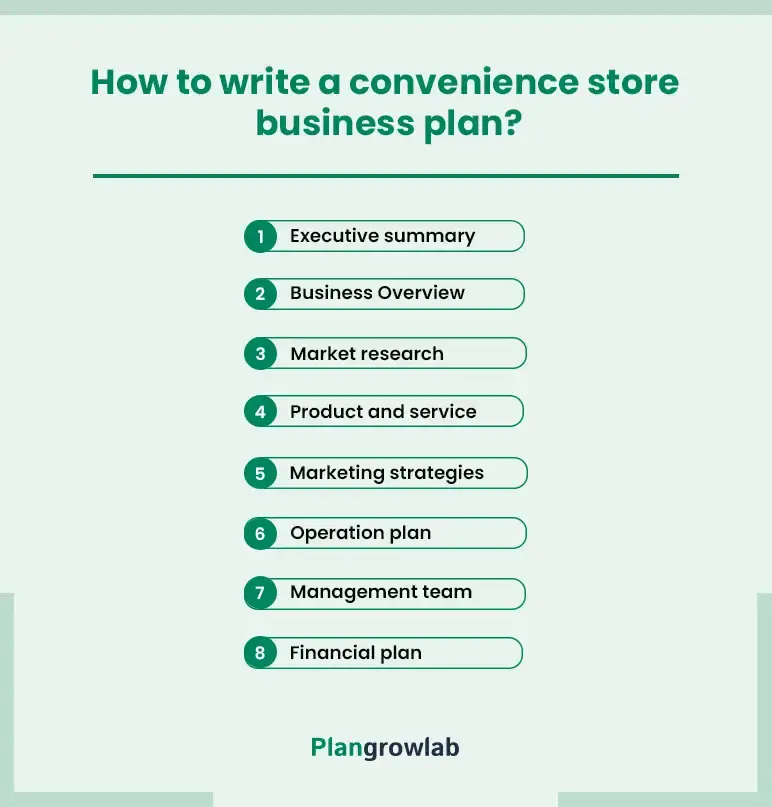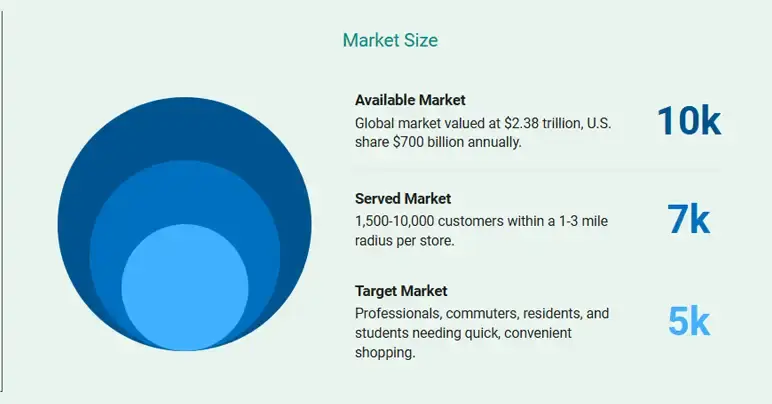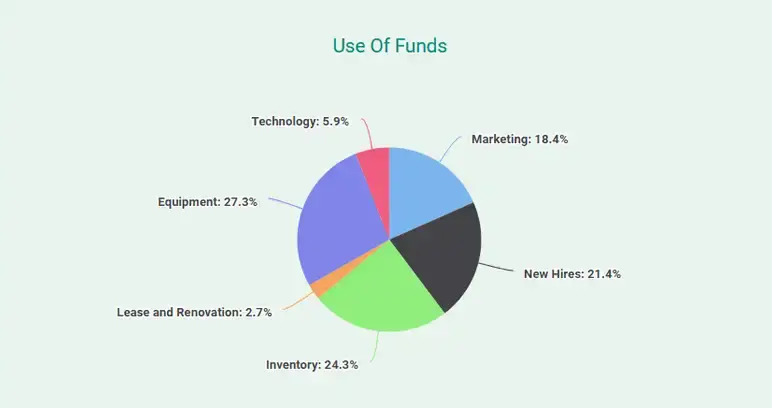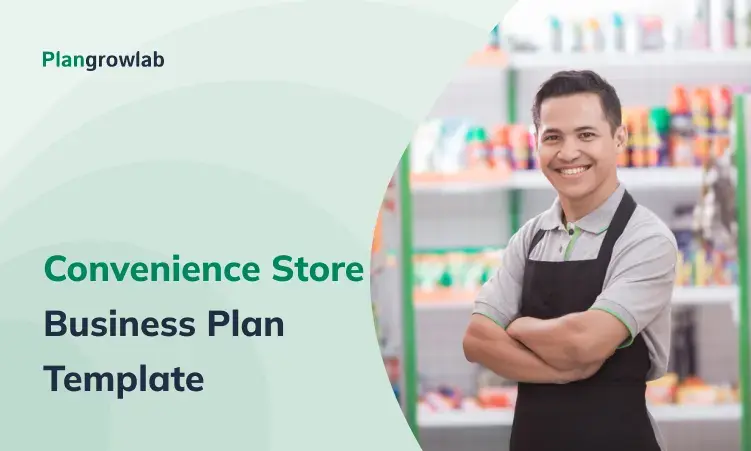A convenience store sounds like a profitable business, doesn’t it? With all essentials under one roof, these stores attract customers all day. But without a solid business plan, things can quickly go wrong.
That’s what Brian Sardelich, CEO of ExtraMile Convenience Stores, realized when he started his store.
I recently spoke with Brian, who shared how creating a business plan helped him organize his finances, plan operations, and stand out in a competitive market.
This article is about that conversation we had, plus a detailed guide on how to create a convenience store business plan.
Why do you need a business plan for a convenience store?
Running a convenience store isn’t just about stocking shelves—it’s about making smart decisions to ensure long-term success.
A comprehensive business plan helps you answer key questions like:
- What will make your convenience store unique?
- Who are your customers?
- How will you manage costs?
- What’s your strategy for standing out?
- What’s your plan for growth?
By answering these questions, you can stay focused, avoid mistakes, and create a business plan for a convenience store that stands out and thrives.
It’s not just a plan—it’s your strategy for success.
How to write a convenience store business plan?
A convenience store business plan explains your mission, goals, and strategies in one clear document. Here's how to get it done!

1. Executive Summary
The executive summary is exactly what it sounds like—a quick summary of your entire business plan.
Think of it as the introduction that gives readers a clear idea of what your convenience store is all about and why it matters. It’s short, to the point, and meant to grab attention.
To write this section, summarize the key points from your entire plan, including:
- Your business idea: What you offer and where you're convenience store located.
- Market research: Who your customers are and why they need your store.
- Products and services: What you’ll sell and what makes it unique.
- Marketing plan: How you’ll attract and retain customers.
- Financial plan: Your goals and how you’ll fund the business.
The goal here’s to make the executive summary concise, engaging, and easy to understand so it gives readers a reason to dive into the rest of your plan. Think of it as your chance to make a great first impression!
“When I wrote the executive summary, I kept it focused on what makes my convenience store unique—a convenient store location, a mix of essentials and specialty items, and the growing demand in the neighborhood.
My advice? Think of it like a quick pitch. Share just enough to grab interest and leave the details for later.” —Brian Sardelich
2. Business Overview
The business overview is your chance to give readers a clear picture of what your convenience store is all about. It’s where you explain your business in detail—what you’re doing, how it’s set up, and what you want to achieve.
You can include things like:
- Your business concept: What kind of convenience store are you opening, and what’s the idea behind it?
- Business structure: Are you running it as a sole proprietorship, partnership, or LLC?
- Business history: If your convenience store already exists, share a little about its journey so far.
- Ownership details: Who owns the business, and what role do they play?
- Mission and vision: Why does your business exist, and where do you see it going?
- Goals: What are your short-term and long-term plans?
- Capital request: If you need funding, explain how much and what it’s for.
This section gives a full picture of your business while keeping it simple and easy to understand. Write it as if you’re explaining your convenience store to someone over coffee—clear, honest, and straightforward.
“Getting the business overview down was tricky because I didn’t want it to sound generic. I focused on what made this convenience store different—serving a local neighborhood with personalized service based on customer preferences. When selecting the store location, we prioritized accessibility, parking availability, and proximity to key customer groups
Once I tied it back to how my convenience store meets the community’s needs, it all started to flow.”—Brian Sardelich
3. Market research
Market research is basically about understanding the market you’re stepping into. It’s your chance to show that there’s a real demand for your convenience store and you know how to meet it.
It’ll help you answer questions like, “Who are my customers? What do they want? Who else is already serving them, and how can I do it better than other convenience store chains in the market?”
One tip here—don’t just throw out facts. Connect the dots and explain how the market trends and data you’re sharing actually support your business idea.
For example, if one of your customer profiles highlights a rise in grab-and-go meals or healthier snack options, you can tie that directly to your store’s offerings, especially if your store is strategically located near schools or office hubs.
Your competitive analysis can further emphasize how these offerings differentiate your convenience store from others in the area.
You can also highlight your TAM (total market size), SAM (Serviceable Available Market), and SOM (Share of Market) to help show your target market potential. These figures clarify where your business fits and how much opportunity there is.

“Market research took some digging, but it was worth it. I started by looking at the local population and other convenience stores to see what was missing. While doing research I saw local families preferred more fresh food options.
By identifying these precise demographics, I adjusted my product mix to meet their needs.”—Brian Sardelich
4. Product and service
The product and services section is where you bring your convenience store to life. It’s your chance to show what you’ll offer, why it’s valuable, and how it sets your business apart.
Think about what your customers need most. Is it a quick essentials like snacks, beverages, and cleaning supplies that can serve commuters looking for convenience on the go?
Or maybe you’re adding something unique, like fresh coffee, healthier options, lottery tickets, or locally sourced goods? This is where you highlight what makes your convenience store special.
One thing to keep in mind—your product mix matters. A good balance between affordable everyday items and higher-margin specialty products can help you cater to a wide range of customers while improving your profit margins and overall profitability.
Don’t forget to talk about quality. How will you ensure your products are fresh, well-stocked, and organized? Customers appreciate convenience stores that feel clean, reliable, and inviting.
Finally, touch on your pricing strategy. Will you focus on competitive pricing or premium products with added value?
5. Marketing strategies
The marketing strategies section is all about how you’ll get customers in the door and keep them coming back. It’s your chance to show that you’ve got a clear plan to attract attention and build customer loyalty—in this competitive convenience store industry that you’re about to penetrate.
Start with understanding your audience:
- Who are your customers? Does your store primarily target residents, commuters, or students?
- Knowing your audience helps you focus your marketing on what they actually need.
Now, think about how you’ll reach them:
- Leverage local advertising: Flyers, posters, or even partnering with nearby small businesses can create strong community connections.
- Incorporate a promotions strategy: Offer discounts on ready-to-eat meals or partner with local publications to advertise events.
- Hosting community events or offering limited-time promotional strategies like loyalty rewards is another way to build a loyal customer base.
One great tip is to use digital tools to your advantage for your convenience store business plan:
- A simple website, social media platform, and even Google My Business can make it easy for people to find you.
- Post updates about new products, deals, or events to keep your convenience store top of mind.
Focus on customer satisfaction by ensuring your store delivers a clean, well-organized environment and friendly customer service.
Lastly, make sure to track what’s working. Whether it’s foot traffic after a campaign or sales increases from a promotion, measuring your efforts helps you refine your strategy over time.
“My initial goal was to attract new customers in the neighborhood, so I offered a grand opening discount and partnered with a local bakery to feature their products. It created a buzz and brought in first-time shoppers who became regulars.
My tip? Collaborate with other businesses—it benefits everyone.”—Brian Sardelich
6. Operation plan
The operations plan is where you prove that your convenience store isn’t just a great idea—it’s built to run smoothly every single day. It’s all about showing how you’ll bring your business to life in the most efficient and organized way possible.
Imagine your convenience store in action. How will you make sure shelves are always stocked, checkouts are quick, and customers leave happy? To achieve this, you’ll need to hire employees who are well-trained and can deliver excellent customer service.
The equipment and tools you choose are just as important. Reliable cash registers, well-organized shelves, fresh coolers, and security cameras all contribute to a safe, efficient, and welcoming space.
And let’s be real—things don’t always go perfectly. Whether it’s delayed deliveries or unexpected staffing issues, so add a backup plan that proves you’re ready for anything.
“Planning how my convenience store would run day-to-day was a bit overwhelming at first. Managing inventory was the biggest question mark for me.
I solved it by setting up an ordering system that tracks fast-moving items and avoids overstocking. Keeping things organized made the whole plan feel more manageable.”—Brian Sardelich
7. Management team
The management team section is where you talk about the people who will make your convenience store run smoothly. It’s your chance to show that you’ve got the right team to make your business a success.
Start with yourself. Why are you opening this convenience store? What skills or experience do you have that make you the right person for the job? Maybe you’ve worked in the convenience store industry before, managed people, or just loved serving customers.
Next, talk about your team. Do you have a manager to handle daily operations or staff to stock shelves and run the cash register? Highlight how they’ll help keep the store running efficiently.
If you’re working with any advisors, like a business coach or accountant, mention them too. It shows you have the support to make smart decisions.
Finally, share how you’ll keep your team motivated, like offering fair pay or bonuses. A happy team means happy customers—and a thriving convenience store business.
“As the owner, I wanted to show that I could handle the business, but I also knew I couldn’t do it alone.
I highlighted my retail experience and included plans to hire reliable staff to provide excellent customer service and inventory management. My advice? Build a team that shares your vision—you can’t do it all.”—Brian Sardelich
8. Financial plan
The financial plan shows how your convenience store will make money, cover its costs, and grow. It’s your way of proving that your business isn’t just a good idea—it’s financially solid.
Start by outlining your key assumptions. How many customers do you expect each day, how much will they spend on average, and what are the primary cost drivers impacting your operational expenses?
Then, talk about when your convenience store will break even. This is the point where your sales will cover all your costs—it’s an exciting milestone and shows your store is on track.
Include key financial reports, like:
- Profit and loss statement
- Cash flow statement
- Balance sheet
- Financial requirements
Break down capital expenditures and marketing expenses to show how you’ll allocate funds effectively while maximizing return on investment.
If you plan to approach private investors for secure funding for your convenience store, explain how much you need and why—like stocking inventory, buying equipment, or marketing.

If your store offers credit to customers or partners, explain how you’ll manage accounts receivable.
“The financial plan took the most time. Estimating costs like rent, inventory, and utilities wasn’t too hard, but projecting net income felt like a guessing game at first. Breaking it into categories like daily sales and seasonal peaks helped.
My tip? Always include a buffer for unexpected expenses—it’s a lifesaver.”—Brian Sardelich
Download free convenience store business plan template
Writing your convenience store business plan doesn’t have to be complicated. Download our free convenience store business plan template in PDF format and let us guide you through the entire process.
This template is designed to help you create a detailed and structured plan that covers everything. With clear examples and actionable insights, it’s the perfect tool to get your convenience store business started on the right track.
Get help writing your business plan
Hope this guide has given you a clear understanding of how to create a detailed business plan for your convenience store. With the right plan in place, you're set to achieve long-term success and stand out in a competitive market.
And we can help you with that exactly. Our business plan consultants will collaborate with you to write, review, and finalize your plan, ensuring it’s customized to your business goals and ready to impress investors.
Download the template now, and let us support you in taking the next step toward launching your new convenience store!
Frequently Asked Questions
What key elements should I include in the executive summary?
The executive summary should include
- Your business name
- Mission statement
- An overview of your products and services
- Your target market
- Competitive advantage
- Funding needs
- Marketing initiatives
How can I present my convenience store business plan to investors?
Present your comprehensive business plan in a clear, professional format, emphasizing key points such as market opportunities, financial projections, and your competitive edge.
Use visuals like charts and graphs to make complex data easier to understand. Additionally, incorporating loyalty programs into your strategy can show investors that you have a plan to retain customers over the long term.
What financial projections are included in a successful convenience store business plan?
A successful plan includes projected income statements, cash flow statements, balance sheets, break-even analysis, and an assessment of your working capital to demonstrate your ability to maintain smooth operations.
These adjustments incorporate financial highlights seamlessly while emphasizing their importance in a business plan.
How long does it take to create a convenience store business plan?
On average, creating a business plan can take around 20–40 hours. However, the exact time required depends on your approach.
A DIY method using templates may take longer while hiring a professional writer can streamline the process to just a few weeks. Alternatively, using business plan software can significantly reduce the time and effort involved.

